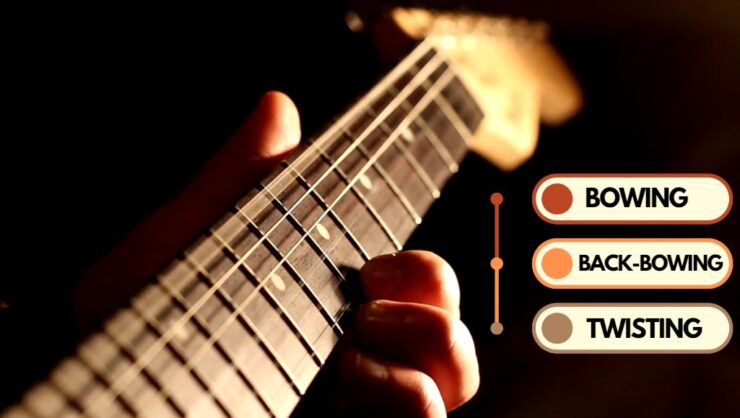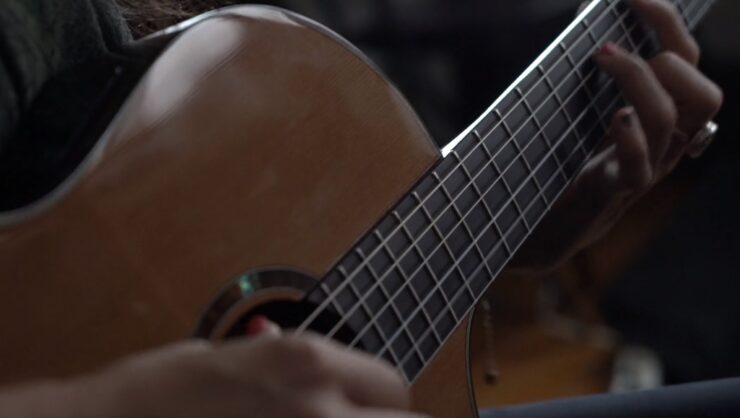If you’re a guitar player, you may have heard of the term “warped neck.” But what exactly does it mean? It is known to cause significant problems for a guitar player, including buzzing strings, difficulty playing certain chords, and overall poor tone. In this blog post, we’ll dive into what a warped guitar neck is, what causes it, and how to fix it.
What Does This Term Mean?
A warped guitar neck is a condition where the neck of a guitar becomes twisted or bent, resulting in an uneven playing surface. This can make playing certain chords or notes difficult or impossible and can also cause buzzing or rattling sounds when playing.
The necks in this condition are typically caused by changes in temperature and humidity. Wood, the primary material used to make guitar necks, expands and contracts with changes in temperature and humidity. Over time, this can cause the neck to become warped or twisted, resulting in an uneven playing surface.
Types of Warped Guitar Necks

There are several types of warped guitar necks, including:
- Bowing: This is when the neck of the guitar curves slightly inward, making the strings sit closer to the fretboard.
- Back-bowing: This is the opposite of bowing, where the neck curves outward, causing the strings to sit further away from the fretboard.
- Twisting: This is when the neck of the guitar twists, causing the fretboard to become uneven.
What Causes This?
As mentioned earlier, changes in temperature and humidity are the primary causes of a warped guitar neck. But other factors can contribute to this condition, including:
- Poor Quality Materials: Using low-quality wood to make a guitar neck can make it more prone to warping.
- Improper Storage: Storing a guitar in an area with extreme temperature or humidity fluctuations can cause the neck to warp over time.
- String Tension: Using heavy gauge strings or tuning a guitar too high can put excessive tension on the neck, causing it to warp.
- Truss Rod Issues: A truss rod is a metal rod inside the neck of a guitar that helps to counteract the tension caused by the strings. If the truss rod is not adjusted properly, it can contribute to a warped neck.
How to Fix a Warped Guitar Neck

If you’re experiencing this issue, there are several ways to fix it. The method you choose will depend on the severity of the warp and your level of experience with guitar maintenance. Here are some common methods:
1. Truss Rod Adjustment
As mentioned earlier, the truss rod is a metal rod inside the neck of a guitar that helps to counteract the tension caused by the strings. By adjusting the truss rod, you can help straighten out the neck and reduce the amount of warping. However, adjusting the truss rod can be tricky and should only be attempted by experienced guitar players or professionals.
2. Bridge Adjustment
The bridge of a guitar is the piece that anchors the strings to the body. By adjusting the height of the bridge, you can change the tension on the strings and help compensate for a warped neck. This method is not as effective as adjusting the truss rod, but it can help reduce the amount of buzzing and improve overall playability.
4. Fret Leveling
If the frets on a guitar are uneven, they can contribute to a warped neck. By leveling the frets, you can help reduce the amount of warping and improve the overall playability of the guitar.
5. Heat Press
This method involves using heat and pressure to straighten out a warped neck. This method should only be attempted by professionals, as it can cause significant damage to the guitar if done improperly.
Preventing a Warped Guitar Neck
While a warped neck can be fixed, prevention is always the best course of action. Here are some tips to help prevent this issue:
- Proper Storage: Storing your guitar in a stable environment with consistent temperature and humidity levels can help prevent warping.
- Regular Maintenance: Keeping your guitar properly maintained can help prevent warping. This includes regular string changes, cleaning the fretboard, and ensuring that the truss rod is properly adjusted.
- Proper String Tension: Using the appropriate string gauge for your guitar and tuning it properly can help reduce the amount of tension on the neck.
- Quality Materials: Investing in a guitar made from high-quality materials can help reduce the likelihood of warping.
Frequently Asked Questions
1. What causes a guitar neck to warp?
Changes in temperature and humidity are the primary causes of a warped guitar neck. Other factors that can contribute to a warped neck include poor quality materials, improper storage, excessive string tension, and truss rod issues.
2. Can a warped guitar neck be fixed?
Yes, a warped guitar neck can be fixed. The method used to fix it will depend on the severity of the warp and the level of experience of the guitar player or technician. Common methods include truss rod adjustment, bridge adjustment, fret leveling, and heat press.
3. Can I prevent this issue?
Yes, a warped guitar neck can be prevented by storing the guitar in a stable environment with consistent temperature and humidity levels, regular maintenance, using the appropriate string gauge and tuning, and investing in a guitar made from high-quality materials.
4. How do I know if my guitar neck is warped?

The most common signs of a warped guitar neck are buzzing or rattling sounds when playing, difficulty playing certain chords or notes, and an uneven playing surface. Visual cues may include a bowing or twisting of the neck.
5. Can I fix a warped guitar neck myself?
While it is possible to fix a warped guitar neck yourself, it is recommended that you only attempt it if you have experience with guitar maintenance. Improperly attempting to fix a warped neck can cause significant damage to the guitar. It’s always best to consult with a professional guitar technician if you’re unsure of how to proceed.
Closing Thoughts
A warped guitar neck can be a frustrating problem for any guitar player. However, with the right knowledge and tools, it can be fixed or prevented. If you’re experiencing this, it’s important to assess the severity of the issue and choose the appropriate method for fixing it.
And, as always, prevention is the best course of action. By taking steps to properly maintain your guitar and store it in a stable environment, you can help reduce the likelihood of a warped neck and ensure that your guitar stays in top playing condition.
We recently published an article about how to tune a guitar with a piano, so make sure to check if you want your favorite string instrument to sound amazing at all times.

